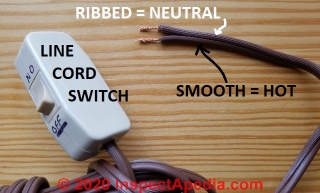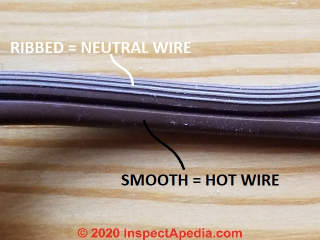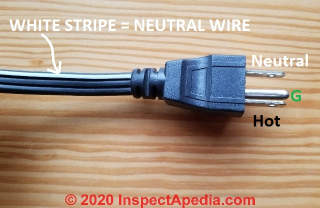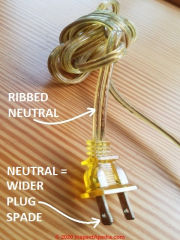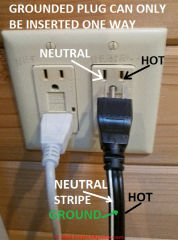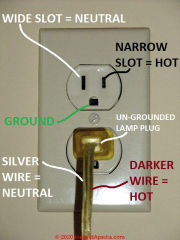 Electrical Wall Plug Wire ID & Connections
Electrical Wall Plug Wire ID & Connections
How to identify the hot, neutral, ground wires in an lamp cord, appliance cord, or other electrical cord wall plugs
- POST a QUESTION or COMMENT about how to install and wire electrical outlets or receptacles in buildings.
How to identify the hot & neutral wires by color, by ribbing on the zip cord or lamp cord, or by a white strip on the zip cord or lamp cord to be sure that your wall plug is wired properly.
Watch out: mis-wired electrical wall plugs or any other electrical wiring is dangerous, risking fire or shock or even death. Electrical wiring should be performed by a licensed, trained electrician and should comply with the National Electrical Code and local regulations. This article series describes how to choose, locate, and wire an electrical receptacle in a home.
InspectAPedia tolerates no conflicts of interest. We have no relationship with advertisers, products, or services discussed at this website.
- Daniel Friedman, Publisher/Editor/Author - See WHO ARE WE?
Electrical Wire Identification at a wall plug or line cord
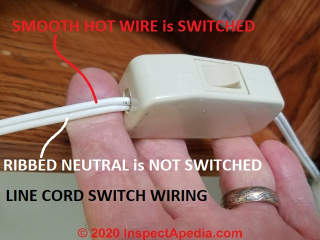 How do we know which wire in a line cord should be wired to the neutral or wide-space of a wall plug?
How do we know which wire in a line cord should be wired to the neutral or wide-space of a wall plug?
Why is knowing this detail important? Here we answer those questions. Photo: a add-on line cord switch used to turn a bedside lamp on and off should be wired so that the switch interrupts the hot wire, not the neutral wire.
Our page top illustration shows an un-grounded lamp cord wall plug connected to an electrical receptacle.
Older non-polarized wall plugs may have just two connecting spades, each the same size. Still you can easily identify which wire is the "hot" and which is the "neutral" in these line cords and wall plugs by observing any of several indicators we list below.
If the plug is not a polarized model, why should you care which wall plug is hot and which is neutral? After all, our building's electrical circuits are mostly 120VAC or 240VAC - where "AC" means "alternating current".
An electrical device will "work" regardless of which way the plug is inserted.
The answer is that some electrical devices are unsafe if polarity is reversed. Some of the hazards are subtle. Here are examples:
- A lamp bulb socket,
connected properly, hides its "live" terminal as a spot deep in the lamp base, but if wiring is reversed, the more-easily-touched bulb socket shell becomes live and can shock or kill someone. - It is important that a line cord switch,
(shown above) often added to a lamp cord or other electrical device, is wired to interrupt the "hot" wire, not the "neutral" wire. Otherwise power remains live at the input to the device that you think is switched safely-off, increasing the potential shock or fire hazard. - On some appliances
such as the igniter circuit of a gas cooktop or range, reversed polarity can cause an electric shock on touching the igniter or burner top even when the burner is "off" - see details in reader comments found
at GAS COOKTOP or STOVE IGNITER REPAIR
Details about the hazards of reversed polarity are
at REVERSED POLARITY ELECTRICAL DEVICES / CIRCUITS
[Click to enlarge any image]
How to Identify the Hot and Neutral Wires in a Line Cord or "Zip Cord" Wire
Look for any of the following:
- The ribbed side
of the line cord indicates the neutral wire, the smooth side, the hot wire.
If we are wiring a line cord plug, the ribbed wire would connect to the wider space or neutral space on the plug itself.
If we are wiring a line cord switch such as shown in our photo, we take care that the switch interrupts the "hot" or smooth wire.
Below we show a closeup of the ribbing along the neutral side or neutral wire of a line cord.
Below: white stripe indicates the neutral wire in this line cord.
- A white stripe
on one side of the line cord indicates the neutral wire, as shown above.
A near-transparent lamp cord used to operate a table lamp provides an example of identification of the neutral wire by noticing that the neutral wire is silver while the hot or "line" wire is copper colored.
- If the line cord is transparent
you may see that there is a silver wire (neutral) and a copper-colored wire (hot).
Really? Not always. As we illustrate below, some clear or translucent line cords will use two copper-colored wires, and others may use two silver-colored wires.
In that case you should expect one side of that line cord to bear ribs along the length of the neutral wire.
- The wider spade of the wall plug
marks which side of the plug is the "neutral" and should be inserted into the wider slot in the electrical receptacle (and cannot be inserted improperly in most modern receptacles).
- A wall plug that includes a ground prong
will force the plug to be inserted properly into the receptacle, as we illustrate below.
Shown earlier on this page (discussing use of a white stripe to mark the neutral wire), this particular grounded line-cord plug does not sport connector-spades of different widths; both are the same, but as we illustrate above, it is impossible to insert this plug incorrectly into the wall receptacle.
Below: we illustrate that not all electrical receptacles and line cord plugs require polarity.
- Non-Polarized Wall Plugs & Receptacles
include this 240VAC electrical outlet and line cord plug in use in an apartment in Venice, Italy.
These cord wires and line cord plugs will not distinguish between the two wires, and both wires carry line voltage, typically at 120VAC, to provide 240VAC across the circuit.
...
Continue reading at ELECTRICAL OUTLET, HOW TO ADD & WIRE - home, or select a topic from the closely-related articles below, or see the complete ARTICLE INDEX.
Or see these
Electrical Receptacle Wiring Articles
- ELECTRICAL OUTLET, HOW TO ADD & WIRE - home
- ELECTRICAL WALL PLUG WIRING ID & CONNECTIONS
- SPLICING ELECTRICAL WIRES
- STRIPPING ELECTRICAL WIRES
Suggested citation for this web page
ELECTRICAL WALL PLUG WIRING ID & CONNECTIONS at InspectApedia.com - online encyclopedia of building & environmental inspection, testing, diagnosis, repair, & problem prevention advice.
Or see this
INDEX to RELATED ARTICLES: ARTICLE INDEX to ELECTRICAL INSPECTION & TESTING
Or use the SEARCH BOX found below to Ask a Question or Search InspectApedia
Ask a Question or Search InspectApedia
Try the search box just below, or if you prefer, post a question or comment in the Comments box below and we will respond promptly.
Search the InspectApedia website
Note: appearance of your Comment below may be delayed: if your comment contains an image, photograph, web link, or text that looks to the software as if it might be a web link, your posting will appear after it has been approved by a moderator. Apologies for the delay.
Only one image can be added per comment but you can post as many comments, and therefore images, as you like.
You will not receive a notification when a response to your question has been posted.
Please bookmark this page to make it easy for you to check back for our response.
IF above you see "Comment Form is loading comments..." then COMMENT BOX - countable.ca / bawkbox.com IS NOT WORKING.
In any case you are welcome to send an email directly to us at InspectApedia.com at editor@inspectApedia.com
We'll reply to you directly. Please help us help you by noting, in your email, the URL of the InspectApedia page where you wanted to comment.
Citations & References
In addition to any citations in the article above, a full list is available on request.
- Timothy Hemm has provided photographs of various electrical defects used at the InspectAPedia TM Website. Mr. Hemm is a professional electrical inspector in Yucala, CA.
- Mark Cramer Inspection Services Mark Cramer, Tampa Florida, Mr. Cramer is a past president of ASHI, the American Society of Home Inspectors and is a Florida home inspector and home inspection educator. Mr. Cramer serves on the ASHI Home Inspection Standards. Contact Mark Cramer at: 727-595-4211 mark@BestTampaInspector.com
- John Cranor [Website: /www.house-whisperer.com ] is an ASHI member and a home inspector (The House Whisperer) is located in Glen Allen, VA 23060. He is also a contributor to InspectApedia.com in several technical areas such as plumbing and appliances (dryer vents). Contact Mr. Cranor at 804-873-8534 or by Email: johncranor@verizon.net
- [3] NFPA - the National Fire Protection Association can be found online at www.nfpa.org
- [4] The NEC National Electrical Code (ISBN 978-0877657903) - NFPA might provide Online Access but you'll need to sign in as a professional or as a visitor)
- US NEC Free Access: See up.codes at this link: https://up.codes/code/nfpa-70-national-electrical-code-2020
- [5] Special thanks to our reader Steve who pointed out prior errors in our illustrations.
- [6] Simpson Strong-Tie, "Code Compliant Repair and Protection Guide for the Installation of Utilities in Wood Frame Construction", web search 5/21/12, original source strongtie.com/ftp/fliers/F-REPRPROTECT09.pdf, [copy on file as /Structures/Framing/Simpson_Framing_Protectors.pdf ]. "The information in this guide is a summary of requirements from the 2003, 2006 and 2009 International Residential Code (IRC), International Building Code (IBC), International Plumbing Code (IPC), International Mechanical Code (IMC), 2006 Uniform Plumbing Code (UPC) and the 2005 National Electrical Code."
- "Electrical System Inspection Basics," Richard C. Wolcott, ASHI 8th Annual Education Conference, Boston 1985.
- "Simplified Electrical Wiring," Sears, Roebuck and Co., 15705 (F5428) Rev. 4-77 1977 [Lots of sketches of older-type service panels.]
- "How to plan and install electric wiring for homes, farms, garages, shops," Montgomery Ward Co., 83-850.
- "Simplified Electrical Wiring," Sears, Roebuck and Co., 15705 (F5428) Rev. 4-77 1977 [Lots of sketches of older-type service panels.]
- "Home Wiring Inspection," Roswell W. Ard, Rodale's New Shelter, July/August, 1985 p. 35-40.
- "Evaluating Wiring in Older Minnesota Homes," Agricultural Extension Service, University of Minnesota, St. Paul, Minnesota 55108.
- "Electrical Systems," A Training Manual for Home Inspectors, Alfred L. Alk, American Society of Home Inspectors (ASHI), 1987, available from ASHI. [DF NOTE: I do NOT recommend this obsolete publication, though it was cited in the original Journal article as it contains unsafe inaccuracies]
- "Basic Housing Inspection," US DHEW, S352.75 U48, p.144, out of print, but is available in most state libraries.
- In addition to citations & references found in this article, see the research citations given at the end of the related articles found at our suggested
CONTINUE READING or RECOMMENDED ARTICLES.
- Carson, Dunlop & Associates Ltd., 120 Carlton Street Suite 407, Toronto ON M5A 4K2. Tel: (416) 964-9415 1-800-268-7070 Email: info@carsondunlop.com. Alan Carson is a past president of ASHI, the American Society of Home Inspectors.
Thanks to Alan Carson and Bob Dunlop, for permission for InspectAPedia to use text excerpts from The HOME REFERENCE BOOK - the Encyclopedia of Homes and to use illustrations from The ILLUSTRATED HOME .
Carson Dunlop Associates provides extensive home inspection education and report writing material. In gratitude we provide links to tsome Carson Dunlop Associates products and services.


